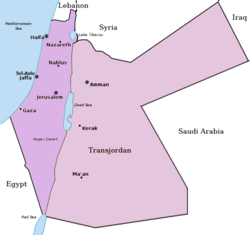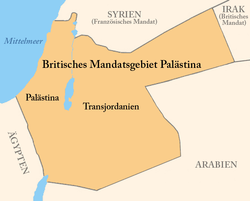Transjordan
Transjordan , East Bank ( Arabic شرق الأردن, DMG Šarq al-Urdunn ), or Kerak , denotes the area east of the Jordan and was the official state name of Jordan until 1950 . Transjordan was a founding member of the Arab League on March 22, 1945 .
The territorial changes after the First World War were recorded in 1920 at the Sanremo Conference and in the Treaty of Sèvres with the Ottoman Empire and the revised version of the treaty of 1923 in Lausanne . The decision made in Sanremo to transfer what is now Jordan to Great Britain as part of the League of Nations mandate for Palestine was ratified by the League of Nations on April 24, 1922 . The area of Palestine of the League of Nations was divided into an eastern Transjordan and a western Cisjordan . The wishes of the population were not taken into account. The goal of an independent state was only formulated in the medium term.
On July 1, 1922, the existing British military administration was converted to a civil administration under the first British High Commissioner Herbert Louis Samuel . In 1923 the semi-autonomous emirate of Transjordan was established. In 1933, the total population of Transjordan was estimated at 300,000, of whom 130,000 were sedentary. Since the League of Nations mandate area of Palestine was divided, Amman has been the capital of the eastern part.
prehistory
For centuries, the area of Transjordan was part of the Ottoman Empire, which after the defeat against the Entente powers and the resignation of the last Sultan Mehmed VI. had ceased to exist. During the First World War, the British had given the Arabs ( Hussein-McMahon correspondence 1915/16) hope of state independence in an area including Syria and Iraq in order to induce them to revolt against the Turks. London only made reservations about southern Mesopotamia and the Syrian coastal region. The King of Hejaz , also Sherif of Mecca , Hussein ibn Ali , and his sons, played a prominent role in the revolt against Ottoman rule. His son Faisal declared the independence of the Arabs on June 5, 1916, which marked the beginning of the " uprising in the desert " .
Despite the loss of sympathy by Great Britain and the expulsion of the family from the Hejaz (which they had ruled since 1201) by Abd al-Aziz ibn Saud in 1924, two of his sons became the first kings of Transjordan and Iraq.
Great Britain and France , the second mandate power in the Middle East, had already divided the land between the Levant and the Persian Gulf into spheres of interest through the Sykes-Picot Agreement in May 1916 . An essential point in this was that each country could freely determine its national borders within its territory. Great Britain received the League of Nations mandate for Palestine and the British mandate for Mesopotamia in what is now Iraq , while the French zone of influence included the League of Nations mandate for Syria and Lebanon .
In November 1917, the British Foreign Secretary Balfour sent the Balfour Declaration to Lord Rothschild , a prominent British Zionist , in which Britain expressed its will to establish a national homestead for the Jewish people . This letter received international approval and binding force under international law through its inclusion in the treaties of the League of Nations.
Politically, the aim was on the one hand to induce American Jews to support the USA entering the war , on the other hand to promote the image of Great Britain as a representative of the stateless peoples. The leading Zionist Chaim Weizmann was initially unaware of the British promises made to the Arabs.
At that time, an understanding and understanding between Arabs and Jews was still possible: In the Faisal-Weizmann Declaration , which was signed at the Paris Peace Conference on January 3, 1919 , Emir Faisal, the liberator of Damascus , explicitly accepted the Balfour Declaration . Faisal and Weizmann, as heads of the Zionist delegation, agreed on increased Jewish immigration to Palestine and Muslim control over the holy places of Islam.
Faisal had been a delegate to Jeddah in the Ottoman Parliament, which had been established on the reform initiative of the nationalist Young Turks . His father was Hussein ibn Ali, who, under the influence of the military success of his sons (with the help of the British officer Thomas Edward Lawrence ) , assumed the title of King of the Arab countries, Asir and Yemen on November 2, 1916 , and was elevated to caliphate in 1924. In this respect, Faisal's commitments have a political and legal basis in the historical context.
Following the suggestion of the South African Prime Minister Jan Christiaan Smuts , the League of Nations granted Great Britain the League of Nations mandate for Palestine , combined with the request to implement the Balfour Declaration. This was intended to support both the influx and the closed settlement of Jews - especially on former Ottoman state land. Express care should be taken to ensure that “ nothing is to be done that could impair the civil and religious rights of existing non-Jewish communities in Palestine ” (Preamble, Articles 2 and 6). The Arab leaders rejected the mandate as a legally void machination of the great powers, as it violated their right to self-determination.
Autonomous Emirate of Transjordan
In Transjordan, Abdallah ibn al-Hussain from the Hashimite dynasty was appointed emir in 1921 . The son of Hussein ibn Ali had renounced the throne of Iraq in favor of his brother Faisal I.
In September 1922, before the League of Nations mandate for Palestine came into force, the British government implemented the division of the country into Palestine west of the Jordan and Transjordan east of the Jordan (in an area ratio of 22:78). This happened as a result of a recommendation by the British Colonial Minister Winston Churchill . In the same year, also in fulfillment of the mandate requirements, the Jewish Agency for Palestine was founded. It was supposed to control Jewish immigration, represent Jewish interests vis-à-vis the mandate and support the development of parallel economic and administrative structures. The formal separation took place on March 25, 1923, according to Article 25 of the mandate. Jewish immigrants to the mandate area were now only allowed to settle west of the Jordan or acquire property.
Transjordan gained access to the sea in 1925 by signing an agreement with the young Kingdom of Saudi Arabia , and then the large southern district of Maʿan with the port city of Akaba (al-ʿAqaba). In the same year the British added 60,000 km² of desert in eastern Palestine to Transjordan, which formed an “arm” to Iraq, which was also British, and cut off Syria from the Arabian Peninsula and the Red Desert, the Nefud .
In 1926 the Transjordan Frontier Force (TJFF) was founded. In 1928 a treaty declared Transjordan independent from Great Britain, except in the administration of finances, defense and external security. The British mandate power set up a high commission for this purpose. The first elections were held in 1929. With the establishment of the (camel) mounted Desert Mobile Force in 1930, the foundation stone for the independent Transjordan army was laid. John Bagot Glubb (Glubb Pascha) was essential for the establishment of an independent army . In 1934 diplomatic missions were set up in other Arab states.
During the Second World War , Transjordan supported Great Britain and, with its Desert Mobile Force and the Arab Legion under Glubb Pascha, moved into pro -German Iraq in 1941 and into Syria and Lebanon, which were occupied by Vichy- loyal troops . In 1945 Transjordan was a founding member of the Arab League .
independence
On March 22, 1946, Transjordan gained independence in the Treaty of London . Abdallah ibn Hussain then accepted the title of king as Abdallah I on May 25, 1946. A new constitution was adopted. A new treaty with Great Britain on the regulation of troop deployments established full sovereignty on March 15, 1948. Great Britain, however, continued to pay subsidies .
In 1947, Abdallah was the only Arab ruler to approve the UN's plan to partition Palestine . Nevertheless, Transjordan took part in the Palestine War / Israeli War of Independence from May to November 1948. Of the five fighting Arab armies, only the Transjordan Arab Legion achieved success. After the armistice, Transjordan kept occupied eastern Palestine (since April 1950 called West Jordan, West Bank or also Cis Jordan ). On 1 December 1949, Abdallah was in Jericho to King of all Palestine cry. The annexation of the West Bank was confirmed by the population by vote. Apart from the United Kingdom and Pakistan, this has not been recognized by any other country under international law. This was accompanied by the proclamation of the Hashemite Kingdom of Jordan on May 24, 1950. Abdallah I was murdered in 1951 by Arab extremists in Jerusalem.
The later loss of the West Bank in the Six Day War led to a refugee problem, which resulted in considerable structural problems. The social integration of the Palestinians did not succeed, nor was it promoted for political reasons against Israel . The majority of the East Palestine refugees, who were particularly susceptible to social revolutionary pan-Arabism , were in critical opposition to the ruling conservative upper class in Jordan. They called for a connection to Syria and Egypt . It was not until July 31, 1988 that Jordan's King Hussein I , Abdallah's grandson, formally gave up the territories annexed in 1950. It also opened up the possibility of mutual recognition and the peace agreement concluded in 1994 with the State of Israel, the second state to emerge on the territory of the former Mandate of Palestine.
literature
- TE Lawrence : Seven Pillars of Wisdom .
- Mary C. Wilson: King Abdullah, Britain, and the Making of Jordan. Cambridge University Press, Cambridge [u. a.] 1987, ISBN 0-521-32421-1 .
- Eugene L. Rogan : Frontiers of the State in the Late Ottoman Empire. Transjordan, 1850-1921 (= Cambridge Middle East Studies. Vol. 12). Cambridge University Press, Cambridge [u. a.] 1999, ISBN 0-521-66312-1 .
Individual evidence
- ↑ Amir Abdullah's Bodyguard on Camels with Red, Green and White Standard at Far Left . April 1921. Retrieved July 14, 2013.
Web links
- Mandate text ( Memento of May 13, 2007 in the Internet Archive ) (archived at Internet Archive )
- Chronology (English)

